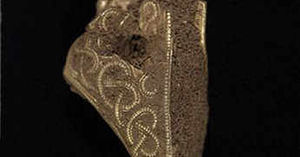Knot found in hoard jewels
Archaeologists have discovered a Staffordshire Knot symbol among the treasures of the Staffordshire Hoard, making the county sign 500 years older than previously thought.


The discovery comes as it emerged a National Lottery bid is being put together to keep the Hoard in the region.
Images of the knot were found on a gold artefact, not previously displayed, that was dug up from a field near Brownhills this summer.
The symbol was believed to originate from the 11th century, but the gold artefact dates back to at least the sixth century.
The discovery will add more weight to calls to keep the Staffordshire Hoard in the region – and it emerged today that a National Lottery bid may centre on plans to create an exhibition at Shugborough or the County Buildings in Stafford.
Staffordshire County Council is putting together the bid to keep the Hoard, which would become a world-class tourist attraction. Council leader Councillor Philip Atkins said: "The Staffordshire knot found on one of the items was 500 years older than the oldest known use of the county symbol."
The council has just chosen to use the knot in its logo in a re-branding exercise. The knot may have originated as a heraldic device for the Anglo-Saxon kingdom of Mercia.
The find of more than 1,500 gold and silver objects by metal detectorist Terry Herbert from Burntwood was the largest hoard of Anglo-Saxon gold ever found and is expected to be valued at more than £1 million. It is now at the British Museum to be valued.
A temporary display of some objects from the hoard is due to open in the British Museum on November 3 following the recent exhibition at Birmingham Museum and Art Gallery.





